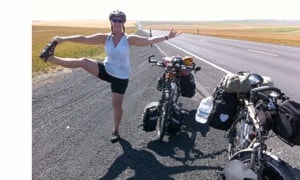This year’s cycle tour takes Heather and I into the neighbour’s backyard. Washington state has always been a favourite destination, primarily due to the warm, no, hot summer weather that can be found in the central part of the state around Lake Roosevelt. We’ve been coming here since our kids were young. This year we have two weeks to make a loop and our planned tour fits the bill.
Thanks to the generous hospitality from our friend Helene, we started in Oliver and crossed the border just south of Osoyoos. Unusually cool weather was in store for our first day, which is actually a good thing. Even though we’ve been putting in the time riding this spring and summer, we chose to keep the distances short for the first few days. Our first destination was the busy little town of Tonasket.
The town is named after Chief Tonasket of the Okanogan people, a local leader from this area who assumed the status of grand chief of the American Okanogan after the drawing of the U.S.-Canada border by the Oregon Treaty of 1846, assuming a leadership role in Okanogan territory formerly held by Chief Nicola who lived north of the border.
Like Quesnel, forestry and agriculture keep things humming here as does tourism. We stayed overnight behind the Tonasket Tourist Centre. The office is also a Warmshowers host – a world wide non-profit organization with members who are typically touring cyclists or just people who want to support those who are travelling on bicycles. Check out www.warmshowers.org. The Tourist Centre offered a cool grassy spot, washrooms and free WiFi. Warmshowers hosts don’t generally charge anything as it’s kind of a reciprocal thing.
We’ve had a number of wonderful people from around the world stay at our place in Quesnel and we’ve had our share of ‘warm showers’ as well.
The Wauconda Pass was our first real climb on our second day of the tour.
It had warmed up considerably so we got an early start to beat the heat.
We arrived in Republic to news of a huge storm that swept through the area three days earlier.
It was the same storm that resulted in the tragic loss of a young boy in Grand Forks. We chose to stay in the community campground but there was no water and no power. We didn’t really miss the power, but the water is essential. Fortunately, we had met a couple from Virginia who offered to transport some water to the campground for us. We had met them at the famous Wauconda Cafe earlier. There are friendly people everywhere.
The next morning we headed south towards the Colville Nation lands where the worst damage from the storm occurred. The storm’s path was indiscriminate. In this area White Pine is the predominant species and whole forests were flattened. Mature trees two to three feet in diameter were snapped off, generally half way up the tree. The fallout took down power lines and smashed houses, trailers and anything that stood in its way. When we arrived in Keller, home base for the local government, it was a scene of emergency preparedness in full swing. Portable accommodation, fresh water, sanitation and hot showers were available. Again, lucky for us the main grocery store was open and water was available there as well. We stopped for a break and met some of the local people who were there when the storm hit. Everyone described it as incredibly scary – like a war zone.
We then headed to the ferry across Lake Roosevelt. Part of Route 21, this is a free service and only takes a few minutes. It dropped us off near our destination for the night, the Keller Ferry Campground. It was a busy place but we found a great spot and set up camp for the night.
On the road at 6 a.m. the next morning as we had a 12-mile hill to climb and had no desire to be doing it later on when it was hot.
The ride was truly wonderful with the sun rising, a cool sage breeze blowing and lots of rattlesnakes. Yup, six of ‘em.
All dead though, from being at the wrong place at the wrong time.
We made it to Wilbur for our second breakfast and the chance to stock up with more water. Wilbur might as well be a town in Alberta. Grain elevators and tractors on the main drag makes one feel like they’ve been transported to another place.
Only another 32 km to go before we get to see the damn dam.
The Grand Coulee Dam is quite a remarkable place to visit.
Built during the Great Depression, it put thousands of people to work. The engineering is phenomenal for its time. Holding back the Columbia River is no mean feat.
The lake just above the dam will be our camp and playground for the next three days.
Can’t wait.
Chris Hartridge is a biking enthusiast and regular Observer contributor.
